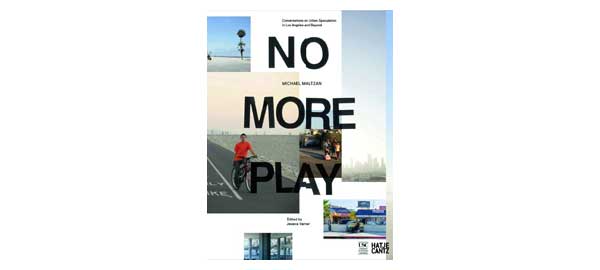Author: Michael Maltzan (Hatje Cantz, 2011)
Through conversations with a photographer, journalist, urban planner, futurist and a number of architect-cum-academics, Michael Maltzan tries to define the dynamics of the City of Los Angeles in No More Play. Fabulous Photos by Iwan Baan engage readers in this sweeping narrative, exposing human interaction with L.A.’s horizontal laboratory of cars, highways and urban ecology.
No more Play is not a book about buildings. Rather, it offers readers a submersion into L.A.’s sea of cultural influence and gives a look at the mechanisms that spur its rapidly changing urban landscape. Each voice offers a personal account that speaks to the past, present and future of Los Angeles, as well as to the world beyond. Catherine Opie, Matthew Coolidge, Mirko Zardini, Edward Soja, Charles Jencks, Qingyun Ma, Sarah Whiting, James Flanigan, and Charles Waldheim describe the events, places, industries and ideas that are the basis for one of the world’s most flagrant economic and cultural cities.
Interviewee Geoff Manaugh, author of BLDGBLOG, creates a vision of L.A. that portrays it as a city that absorbs subcultures rather than a place with a defined cultural grain. In conversation with Manaugh, LA is a place where punks, evangelicals and porn stars can exist and do business in a single city block. He expresses the constant change of the city:
“In Los Angeles, you can always do something else, you can always move on to the next place, you can always find something else to do – but from a resource perspective, can we?”
Seeing the city as a place of infinite rebirth within a finite-resourced world, his vision is a constant in No More Play;
In another interesting exchange, Charles Waldheim offers his take on the horizontal sprawling nature of Los Angeles and the Architects challenge in designing around urban planners to create public space. The conversation shifts to the need for change in resource consumption, and the hybridization of infrastructure to reflect the consumption of imported resources. Waldheim states:
“Some people argue that certain psychological points like gasoline prices in dollars will be the limit, or hours of commute. But the basic conditions for continued sprawl still exist. Land prices are still incredibly cheap, oil prices are still incredibly low, the students at the business schools are still being taught that the shipping costs of goods and supplies are essentially nil. As long as that is still true, I think Sprawl is going to continue.”
Edward Soja continues the conversation, focusing on Los Angeles as a laboratory for urbanization globally. He offers his cautions for adopting the L.A. model in other parts of the world. As an image factory, the city offers a heterogeneous model that functions to encourage massive income gaps, suffering major geographic challenges and social injustices. Although it is far from a democratic city to be copied elsewhere, Soja shows that justice struggles continue to make the city more equitable, citing the Bus Riders Union and it’s effect in improving the bus system for the working poor.
James Flannigan furthers this vision, as he outlines the import boom in 1996 and the relationship between the ‘brain goods’ of southern California to the hard goods of Asian cities in the pacific rim.
Each conversation in No More Fun provides a vision of Los Angeles and collectively they inform a portrait of the city. The book is an engaging and substantial look into one of the worlds major cities, which should be as appealing to Los Angeles natives as to those who have never visited.
***



